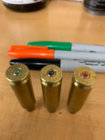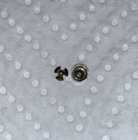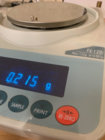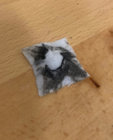It's winter time, I'm bored and it's a great time to do tedious things before next shooting season. I have never weight sorted primers but have a few friends who do. When I asked them if it helped they said they weren't sure. The reason was they never knew if the variation was the priming mix or the metal cup and anvil. Tonight I did a little test to see what I could determine.
I weighed the primers left in a tray of Federal 205M's. 54 total.
1- 0.235 grams, 3.62gr
10- 0.236 grams, 3.64gr
27- 0.237 grams, 3.66gr
14- 0.238 grams, 3.68gr
2- 0.239 grams, 3.70gr
There did not seem to be much variation but I have never weighed primers before so I'm not sure. I picked one of the lightest, median and heaviest, color coded them and loaded them into sized 6.5x47L cases.

Next I fired them, de-primed the cases, pulled the anvils out of the cups and cleaned out the primer residue. I used CLR and a nylon brush but water and a nylon brush would have probably worked. I dried everything prior to re-weighing.

Then I went ahead and weighed everything again:
Primer, Original Weight, Fired Weight, Weight of Primer mix
----1----------0.235g---------0.214g------------0.021g--
----2----------0.237g---------0.215g------------0.022g--
----3----------0.239g---------0.215g------------0.024g--

While this was a very small sample and the results would need to be repeated with a larger test, the results did seem to show that at least in this case with these primers a heavier primer did mean the primer contained more priming compound. The cups and anvils were extremely uniform. All the anvils weighed 0.061g. One of the cups varied from the other two by 0.001g.
One final thing. The next time you blame a powder for being "Dirty" consider this, I fired three primers in a perfectly clean barrel. Here is the patch that came out! Dave.

I weighed the primers left in a tray of Federal 205M's. 54 total.
1- 0.235 grams, 3.62gr
10- 0.236 grams, 3.64gr
27- 0.237 grams, 3.66gr
14- 0.238 grams, 3.68gr
2- 0.239 grams, 3.70gr
There did not seem to be much variation but I have never weighed primers before so I'm not sure. I picked one of the lightest, median and heaviest, color coded them and loaded them into sized 6.5x47L cases.

Next I fired them, de-primed the cases, pulled the anvils out of the cups and cleaned out the primer residue. I used CLR and a nylon brush but water and a nylon brush would have probably worked. I dried everything prior to re-weighing.

Then I went ahead and weighed everything again:
Primer, Original Weight, Fired Weight, Weight of Primer mix
----1----------0.235g---------0.214g------------0.021g--
----2----------0.237g---------0.215g------------0.022g--
----3----------0.239g---------0.215g------------0.024g--

While this was a very small sample and the results would need to be repeated with a larger test, the results did seem to show that at least in this case with these primers a heavier primer did mean the primer contained more priming compound. The cups and anvils were extremely uniform. All the anvils weighed 0.061g. One of the cups varied from the other two by 0.001g.
One final thing. The next time you blame a powder for being "Dirty" consider this, I fired three primers in a perfectly clean barrel. Here is the patch that came out! Dave.

Last edited:










